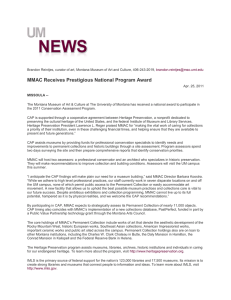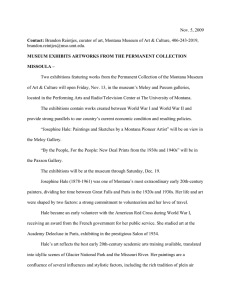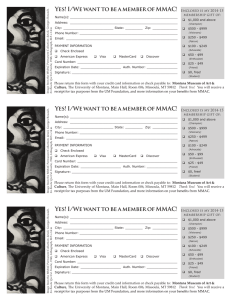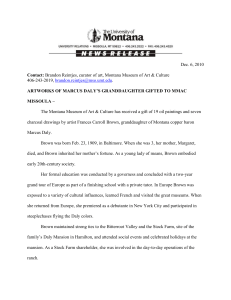III Establishment of Centers Senate Recommendation A. Written Report Summary:
advertisement
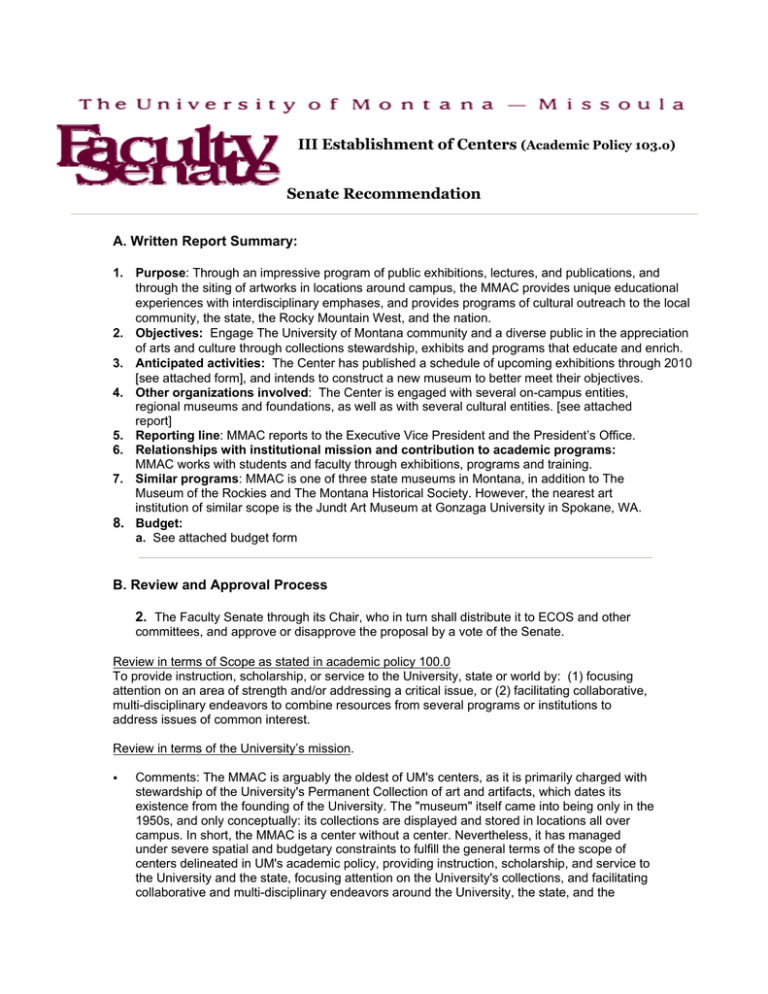
III Establishment of Centers (Academic Policy 103.o) Senate Recommendation A. Written Report Summary: 1. Purpose: Through an impressive program of public exhibitions, lectures, and publications, and through the siting of artworks in locations around campus, the MMAC provides unique educational experiences with interdisciplinary emphases, and provides programs of cultural outreach to the local community, the state, the Rocky Mountain West, and the nation. 2. Objectives: Engage The University of Montana community and a diverse public in the appreciation of arts and culture through collections stewardship, exhibits and programs that educate and enrich. 3. Anticipated activities: The Center has published a schedule of upcoming exhibitions through 2010 [see attached form], and intends to construct a new museum to better meet their objectives. 4. Other organizations involved: The Center is engaged with several on-campus entities, regional museums and foundations, as well as with several cultural entities. [see attached report] 5. Reporting line: MMAC reports to the Executive Vice President and the President’s Office. 6. Relationships with institutional mission and contribution to academic programs: MMAC works with students and faculty through exhibitions, programs and training. 7. Similar programs: MMAC is one of three state museums in Montana, in addition to The Museum of the Rockies and The Montana Historical Society. However, the nearest art institution of similar scope is the Jundt Art Museum at Gonzaga University in Spokane, WA. 8. Budget: a. See attached budget form B. Review and Approval Process 2. The Faculty Senate through its Chair, who in turn shall distribute it to ECOS and other committees, and approve or disapprove the proposal by a vote of the Senate. Review in terms of Scope as stated in academic policy 100.0 To provide instruction, scholarship, or service to the University, state or world by: (1) focusing attention on an area of strength and/or addressing a critical issue, or (2) facilitating collaborative, multi-disciplinary endeavors to combine resources from several programs or institutions to address issues of common interest. Review in terms of the University’s mission. Comments: The MMAC is arguably the oldest of UM's centers, as it is primarily charged with stewardship of the University's Permanent Collection of art and artifacts, which dates its existence from the founding of the University. The "museum" itself came into being only in the 1950s, and only conceptually: its collections are displayed and stored in locations all over campus. In short, the MMAC is a center without a center. Nevertheless, it has managed under severe spatial and budgetary constraints to fulfill the general terms of the scope of centers delineated in UM's academic policy, providing instruction, scholarship, and service to the University and the state, focusing attention on the University's collections, and facilitating collaborative and multi-disciplinary endeavors around the University, the state, and the nation. ECOS does not consider the MMAC controversial. It has amicable and beneficial relations with a range of academic units. Although two thirds of its funding comes from the University, such a proportion of state funding is justified as the MMAC, one of only three state museums in Montana, is primarily concerned with stewarding University property. The most crucial of the MMAC's current goals is the construction of a museum facility. There is no question that such a building is necessary as the MMAC is on the cusp of acquiring a major collection of Native American artifacts, as well as the permanent loan of the Meloy collection of some three to four thousand items. These acquisitions will strain its current exhibition and storage capacity, not to mention its staff and budget. The facility currently planned will provide 33,000 square feet of exhibition and storage space, is projected to cost $11 million and to open in 2015. The MMAC and the UM Foundation are confident that this is a acheiveable goal, and ECOS concurs. Does ECOS/Faculty Senate consider this center controversial? No Is the relationship with academic units beneficial? Yes Is the program revenue neutral or does it consume more resources than it generates? If so, is the use of University resources justified? The program is revenue neutral. Is the entity making progress toward objectives? Yes Recommendation: Approval. Justification: The MMAC has been a responsible steward of state resources.
